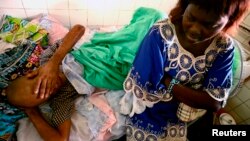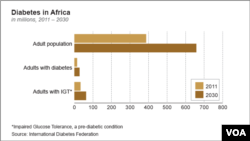DAKAR —
The number of people with diabetes in sub-Saharan Africa is expected to double over the next 20 years. The region currently has the highest mortality rate due to diabetes, as proper diagnosis and treatment remain a problem.
The International Diabetes Federation [IDF] says an estimated 371 million people currently live with diabetes, a chronic disease in which the body can’t properly regulate blood sugar levels.
The World Health Organization [WHO] says that this number is on the rise, particularly in developing countries, where there have been rapid increases in body weight and physical inactivity in recent years - a leading cause of type-2 diabetes.
Dr. Maimouna Ndour Mbaye, an internal medicine specialist at the Marc Sankale National Diabetes Center in Dakar, Senegal, said, “Diabetes has become a big problem in Senegal. Its prevalence is really increasing and is likely to get even higher. Some cases are hereditary, but most of the increase is because of unhealthy lifestyles. Here in Senegal, the food is too rich in fat and sugar. People are also becoming more sedentary. We eat poorly and we sit, and we are getting diabetes.”
There are no exact figures on how many people have diabetes in Senegal, but the IDF estimates that there were more than 160,000 cases in 2012.
The IDF says this figure likely is even higher, as nearly 80 percent of diabetes cases go undiagnosed in Africa.
Fifty-four-year-old Regina Hazoumé was diagnosed with type-2 diabetes more than 20 years ago. She said she currently is able to manage her diabetes, but that others are not so lucky.
She said, “Having diabetes in Senegal can be difficult. We want to do what the doctors say, but people just don’t have the means to live healthy lifestyles. Rice is the staple of each meal here. Bread, too. But diabetics can’t eat those things. And we don’t have the money to afford vegetables or meat, so it’s very difficult.”
If left untreated, diabetes can lead to blindness, kidney failure, the amputation of limbs and even death.
The WHO says that more than 80 percent of diabetes-related deaths occur in low- and middle-income countries, such as Senegal, where people don’t have access to quality health care or the means to afford treatment.
In Senegal, many diabetics say that they are fortunate because the government subsidizes the cost of insulin - the most common medication used to regulate blood sugar levels - from $36 per treatment down to $3 per treatment.
There are many additional costs, however, such as syringes, blood sugar tests, special foods, and other medical expenses that arise from complications related to diabetes, such as hypertension and circulation problems.
For those patients who can’t or don’t want to take insulin shots three times a day, oral medications can cost upwards of $50 month.
Doctor Mbaye said the availability of insulin also is a problem, particularly outside the capital. “Accessing insulin is a huge problem in many African countries. There is a distribution of diabetes medicine here in Senegal, but it often doesn’t reach certain places,” she says. “There is also the problem of proper storage in villages. Insulin needs to be refrigerated."
Mbaye said because diabetes treatment can be difficult and expensive, prevention is key to reducing the burden of the disease.
She said that while type-1 diabetes is hereditary and cannot be prevented, eating a healthy, well-balanced diet and getting regular exercise can reduce a person’s chance of developing type-2 diabetes, and can even eliminate the need for daily insulin treatments.
World Diabetes Day is commemorated each year on November 14 to raise awareness about the disease.
The IDF warns that if nothing is done to stop the growing diabetes epidemic, as many as one in 10 people could suffer from the disease by 2030.
The International Diabetes Federation [IDF] says an estimated 371 million people currently live with diabetes, a chronic disease in which the body can’t properly regulate blood sugar levels.
The World Health Organization [WHO] says that this number is on the rise, particularly in developing countries, where there have been rapid increases in body weight and physical inactivity in recent years - a leading cause of type-2 diabetes.
Dr. Maimouna Ndour Mbaye, an internal medicine specialist at the Marc Sankale National Diabetes Center in Dakar, Senegal, said, “Diabetes has become a big problem in Senegal. Its prevalence is really increasing and is likely to get even higher. Some cases are hereditary, but most of the increase is because of unhealthy lifestyles. Here in Senegal, the food is too rich in fat and sugar. People are also becoming more sedentary. We eat poorly and we sit, and we are getting diabetes.”
There are no exact figures on how many people have diabetes in Senegal, but the IDF estimates that there were more than 160,000 cases in 2012.
The IDF says this figure likely is even higher, as nearly 80 percent of diabetes cases go undiagnosed in Africa.
Fifty-four-year-old Regina Hazoumé was diagnosed with type-2 diabetes more than 20 years ago. She said she currently is able to manage her diabetes, but that others are not so lucky.
She said, “Having diabetes in Senegal can be difficult. We want to do what the doctors say, but people just don’t have the means to live healthy lifestyles. Rice is the staple of each meal here. Bread, too. But diabetics can’t eat those things. And we don’t have the money to afford vegetables or meat, so it’s very difficult.”
If left untreated, diabetes can lead to blindness, kidney failure, the amputation of limbs and even death.
The WHO says that more than 80 percent of diabetes-related deaths occur in low- and middle-income countries, such as Senegal, where people don’t have access to quality health care or the means to afford treatment.
In Senegal, many diabetics say that they are fortunate because the government subsidizes the cost of insulin - the most common medication used to regulate blood sugar levels - from $36 per treatment down to $3 per treatment.
There are many additional costs, however, such as syringes, blood sugar tests, special foods, and other medical expenses that arise from complications related to diabetes, such as hypertension and circulation problems.
For those patients who can’t or don’t want to take insulin shots three times a day, oral medications can cost upwards of $50 month.
Doctor Mbaye said the availability of insulin also is a problem, particularly outside the capital. “Accessing insulin is a huge problem in many African countries. There is a distribution of diabetes medicine here in Senegal, but it often doesn’t reach certain places,” she says. “There is also the problem of proper storage in villages. Insulin needs to be refrigerated."
Mbaye said because diabetes treatment can be difficult and expensive, prevention is key to reducing the burden of the disease.
She said that while type-1 diabetes is hereditary and cannot be prevented, eating a healthy, well-balanced diet and getting regular exercise can reduce a person’s chance of developing type-2 diabetes, and can even eliminate the need for daily insulin treatments.
World Diabetes Day is commemorated each year on November 14 to raise awareness about the disease.
The IDF warns that if nothing is done to stop the growing diabetes epidemic, as many as one in 10 people could suffer from the disease by 2030.








